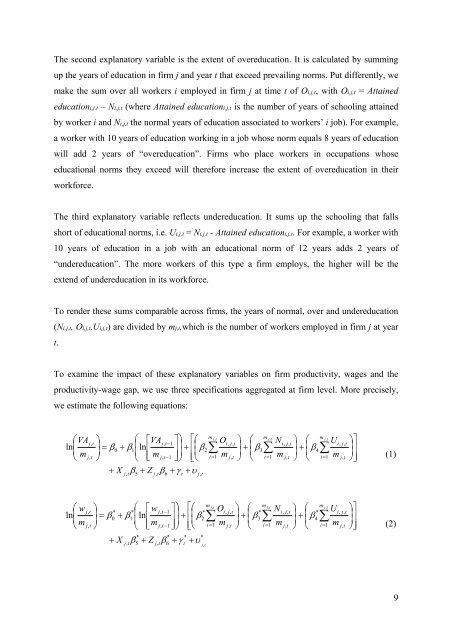CEB Working Paper
240798&r=lma
240798&r=lma
Create successful ePaper yourself
Turn your PDF publications into a flip-book with our unique Google optimized e-Paper software.
The second explanatory variable is the extent of overeducation. It is calculated by summing<br />
up the years of education in firm j and year t that exceed prevailing norms. Put differently, we<br />
make the sum over all workers i employed in firm j at time t of Oi,j,t, with Oi,j,t = Attained<br />
educationi,j,t – Ni,j,t (where Attained educationi,j,t is the number of years of schooling attained<br />
by worker i and Ni,j,t the normal years of education associated to workers’ i job). For example,<br />
a worker with 10 years of education working in a job whose norm equals 8 years of education<br />
will add 2 years of “overeducation”. Firms who place workers in occupations whose<br />
educational norms they exceed will therefore increase the extent of overeducation in their<br />
workforce.<br />
The third explanatory variable reflects undereducation. It sums up the schooling that falls<br />
short of educational norms, i.e. Ui,j,t = Ni,j,t - Attained educationi,j,t. For example, a worker with<br />
10 years of education in a job with an educational norm of 12 years adds 2 years of<br />
“undereducation”. The more workers of this type a firm employs, the higher will be the<br />
extend of undereducation in its workforce.<br />
To render these sums comparable across firms, the years of normal, over and undereducation<br />
(Ni,j,t, Oi,j,t,Ui,j,t) are divided by mj,t,which is the number of workers employed in firm j at year<br />
t.<br />
To examine the impact of these explanatory variables on firm productivity, wages and the<br />
productivity-wage gap, we use three specifications aggregated at firm level. More precisely,<br />
we estimate the following equations:<br />
VA<br />
ln<br />
m<br />
j,<br />
t<br />
j,<br />
t<br />
VA<br />
<br />
<br />
j,<br />
t 1<br />
0<br />
<br />
<br />
<br />
1<br />
ln <br />
<br />
<br />
<br />
m <br />
<br />
j,<br />
t 1<br />
<br />
<br />
<br />
X Z <br />
j,<br />
t<br />
5<br />
j,<br />
t<br />
6<br />
t<br />
j,<br />
t<br />
O<br />
m j , t<br />
i,<br />
j,<br />
t<br />
2<br />
i1 m<br />
j,<br />
t<br />
<br />
<br />
<br />
N<br />
m j , t<br />
i,<br />
j,<br />
t<br />
3<br />
i 1 m<br />
j,<br />
t<br />
<br />
<br />
<br />
U<br />
m j , t<br />
i,<br />
j,<br />
t<br />
4<br />
i 1 m<br />
j,<br />
t<br />
<br />
<br />
<br />
<br />
(1)<br />
w<br />
ln<br />
m<br />
j,<br />
t<br />
j,<br />
t<br />
<br />
* *<br />
w<br />
0<br />
<br />
1<br />
ln<br />
<br />
<br />
<br />
m<br />
X<br />
j,<br />
t<br />
Z<br />
*<br />
5<br />
j,<br />
t 1<br />
j,<br />
t 1<br />
j,<br />
t<br />
*<br />
<br />
*<br />
6<br />
<br />
<br />
<br />
<br />
<br />
<br />
<br />
<br />
<br />
*<br />
t<br />
m j , t<br />
* i,<br />
j,<br />
t<br />
2<br />
i1 m<br />
j,<br />
t<br />
j , t<br />
O<br />
<br />
<br />
<br />
N<br />
m j , t<br />
* i,<br />
j,<br />
t<br />
3<br />
i1 m<br />
j,<br />
t<br />
<br />
<br />
<br />
U<br />
m j , t<br />
* i,<br />
j,<br />
t<br />
4<br />
i1 m<br />
j,<br />
t<br />
<br />
<br />
<br />
<br />
(2)<br />
9


